#historical sites in the netherlands
Explore tagged Tumblr posts
Text
youtube
10 beautiful places to visit in the netherlands | netherlands attractions
Explore the enchanting beauty of the Netherlands in this captivating video as GeographyGuru99 takes you on a journey through the country's top 10 must-visit destinations. From the breathtaking Martinitoren Vista to the iconic windmills of Zaanse Schans and the delectable cuisine at Rotterdam's Markthal, this video showcases the Netherlands in all its glory. While Amsterdam, Utrecht, Rotterdam, and The Hague are well-known tourist hotspots, this video goes beyond the obvious to unveil hidden gems that promise an unforgettable Dutch adventure. If you enjoyed this immersive travel experience, show your support by liking the video, sharing your thoughts in the comments, and subscribing to stay updated on more exciting content. Happy travels! 🌍🇳🇱
#netherlands vacation places#historical sites in the netherlands#netherlands travel destinations#netherlands destinations#places to visit in netherlands#netherlands places to visit#best time to visit netherlands#amazing places to visit in the netherlands#tourist attractions in the netherlands#beautiful places in the netherlands#geography facts#geography#geography guru#10 beautiful places to visit in the netherlands | netherlands attractions#netherlands attractions#Youtube
0 notes
Text

“Blankets” (2023), Chengdu, China.
SpY Challenges Perceptions in Monumental Installations That Reframe Everyday Objects and Historical Sites
All images © SpY

“Zeros” (2023), Beijing, China

“Eclypses” (2022), Oviedo, Spain

“Barrier Tape” (2022), Amsterdam, The Netherlands
#SpY#artist#art#art installations#public art installations#everyday objects#historical sites#chengdu#china#beijing#oviedo#spain#eclypses#zeros#amsterdam#the netherlands
2 notes
·
View notes
Text
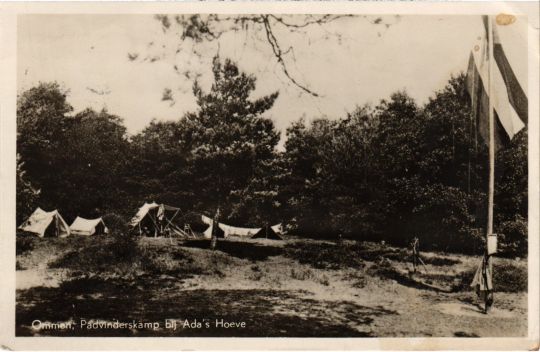
Dutch scouting camp site Gilwell Ada's Hoeve in Ommen, Overijssel, Netherlands
Dutch vintage postcard
#vintage#netherlands#tarjeta#site#old#gilwell#briefkaart#ommen#overijssel#postcard#photography#dutch#postal#carte postale#sepia#scouting#ephemera#historic#hoeve#camp#ansichtskarte#ada#postkarte#postkaart#photo#gilwell ada's
3 notes
·
View notes
Text
Munttoren, Historic Site(Amsterdam, Netherlands) ムント塔★★
I visited Munttoren in Amsterdam (^o^) It stands on the Muntplein, where the Amstel river and the Singel canal meet (^o^)v
アムステルダムにあるムント塔を見て来ました(^o^)
アムステル川とシンゲル運河の合流点にあたるムント広場に建つ塔(^o^)v



0 notes
Text
Exploring Belgium: A Comprehensive Travel Guide
Belgium, a charming country nestled in Western Europe, offers a rich tapestry of history, culture, and modernity. This guide will take you through Belgium’s history, colonial past, political landscape, education system, and practical travel information, ensuring a delightful and informed visit. A Brief History of Belgium Belgium’s history is a blend of influences from Roman times to modern-day…
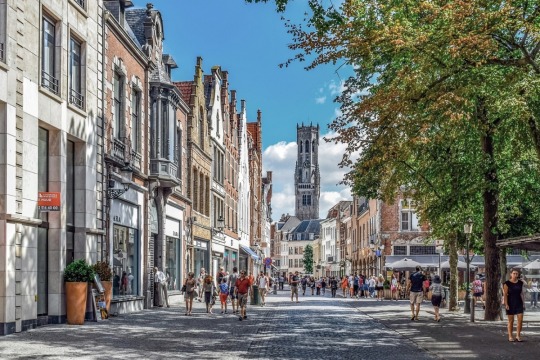
View On WordPress
#a charming country nestled in Western Europe#accommodation#adventure#africa#among other religious communities. Food and Culture Belgium’s cuisine is famous for waffles#and a variety of local beers. Belgium offers a unique blend of history#and Antwerp International Airport (ANR). The country has an excellent public transportation system#and beer. Cultural influences are diverse#and buses. Roads The road infrastructure is well-developed#and French. Belgium gained independence from the Netherlands in 1830#and German in a small eastern region. Is Belgium expensive to visit? Belgium can be pricey#and German). Festivals#and German. Dutch is predominant in Flanders#and historical buildings. Ghent: Famous for its medieval architecture and vibrant cultural scene. Antwerp: Renowned for its diamond district#and major credit cards are widely accepted. Top Places to Visit Brussels: The capital city#and Manneken Pis. Bruges: A picturesque medieval city with canals#and many other countries can enter Belgium visa-free for short stays. Others may need a Schengen visa. The currency is the Euro (EUR)#and modern attractions#and modernity. This guide will take you through Belgium’s history#and music play significant roles in Belgian culture. FAQs about Belgium What languages are spoken in Belgium? Belgium has three official lan#and numerous tours offer tastings and factory visits. Beer Tours: Belgian beer is world-renowned#and practical travel information#and road conditions are generally good. Religion Belgium is predominantly Roman Catholic#and the Brussels-Capital Region. The political landscape is complex#and the stunning Cathedral of Our Lady. Leuven: A lively university town with rich historical sites. Activities for Tourists Chocolate Tasti#and transportation can be expensive#art#Atomium#Austrian#be aware of pickpockets and avoid less-populated areas at night. Accommodation Affordability Belgium offers a range of accommodation options
0 notes
Text
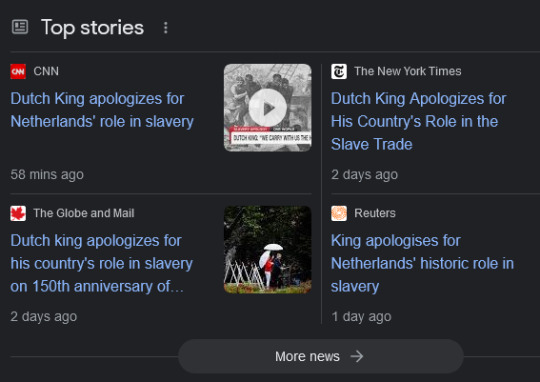
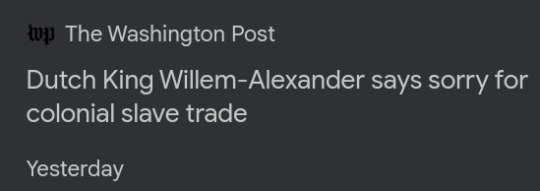
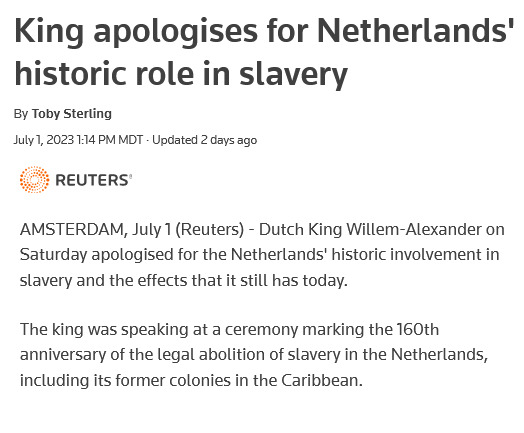
“Dutch King apologizes for Netherlands’ role in slavery.”
The Dutch/Netherlands abducted slaves from West Africa; hosted the Dutch West India Company; operated an extensive profitable sugar plantation industry built on slave labor; and established colonies in the greater Caribbean region including sites at Aruba, Curaçao, Sint Maarten, Bonaire, and the adjacent “Wild Coast” (land between the Orinoco and Amazon rivers, including Guyana and Suriname). Many of these places remained official colonies until between the 1950s and 1990s.
---
Scholarship on resistance to Dutch practices of slavery, colonialism, and imperialism in the Caribbean:
“Decolonization, Otherness, and the Neglect of the Dutch Caribbean in Caribbean Studies.” Margo Groenewoud. Small Axe. 2021.
“Women’s mobilizations in the Dutch Antilles (Curaçao and Aruba, 1946-1993).” Margo Groenewoud. Clio. Women, Gender, History No. 50. 2019.
“Black Power, Popular Revolt, and Decolonization in the Dutch Caribbean.” Gert Oostindie. In: Black Power in the Caribbean. Edited by Kate Quinn. 2014.
“History Brought Home: Postcolonial Migrations and the Dutch Rediscovery of Slavery.” Gert Oostindie. In: Post-Colonial Immigrants and Identity Formations in the Netherlands. Edited by Ulbe Bosma. 2012.
“Other Radicals: Anton de Kom and the Caribbean Intellectual Tradition.” Wayne Modest and Susan Legene. Small Axe. 2023.
Di ki manera? A Social History of Afro-Curaçaoans, 1863-1917. Rosemary Allen. 2007.
Creolization and Contraband: Curaçao in the Early Modern Atlantic World. Linda Rupert. 2012.
“The Empire Writes Back: David Nassy and Jewish Creole Historiography in Colonial Suriname.” Sina Rauschenbach. The Sephardic Atlantic: Colonial Histories and Postcolonial Perspectives. 2018.
“The Scholarly Atlantic: Circuits of Knowledge Between Britain, the Dutch Republic and the Americas in the Eighteenth Century.” Karel Davids. 2014. And: “Paramaribo as Dutch and Atlantic Nodal Point, 1640-1795.” Karwan Fatah-Black. 2014. And: Dutch Atlantic Connections, 1680-1800: Linking Empires, Bridging Borders. Edited by Gert Oostindie and Jessica V. Roitman. 2014.
Decolonising the Caribbean: Dutch Policies in a Comparative Perspective. Gert Oostindie and Inge Klinkers. 2003. And: “Head versus heart: The ambiguities of non-sovereignties in the Dutch Caribbean.” Wouter Veenendaal and Gert Oostindie. Regional & Federal Studies 28(4). August 2017.
Tambú: Curaçao’s African-Caribbean Ritual and the Politics of Memory. Nanette de Jong. 2012.
“More Relevant Than Ever: We Slaves of Suriname Today.” Mitchell Esajas. Small Axe. 2023.
“The Forgotten Colonies of Essequibo and Demerara, 1700-1814.” Eric Willem van der Oest. In: Riches from Atlantic Commerce: Dutch Transatlantic Trade and Shipping, 1585-1817. 2003.
“Conjuring Futures: Culture and Decolonization in the Dutch Caribbean, 1948-1975.” Chelsea Shields. Historical Reflections / Reflexions Historiques Vol. 45 No. 2. Summer 2019.
“’A Mass of Mestiezen, Castiezen, and Mulatten’: Fear, Freedom, and People of Color in the Dutch Antilles, 1750-1850.” Jessica Vance Roitman. Atlantic Studies 14, no. 3. 2017.
---
This list only covers the Caribbean.
But outside of the region, there is also the legacy of the Dutch East India Company; over 250 years of Dutch slavers and merchants in Gold Coast and wider West Africa; about 200 years of Dutch control in Bengal (the same region which would later become an engine of the British Empire’s colonial wealth extraction); over a century of Dutch control in Sri Lanka/Ceylon; Dutch operation of the so-called “Cultivation System” (”Cultuurstelsei”) in the nineteenth century; Dutch enforcement of brutal forced labor regimes at sugar plantations in Java, which relied on de facto indentured laborers who were forced to sign contracts or obligated to pay off debt and were “shipped in” from other islands and elsewhere in Southeast Asia (a system existing into the twentieth century); the “Coolie Ordinance” (”Koelieordonnanties”) laws of 1880 which allowed plantation owners to administer punishments against disobedient workers, resulting in whippings, electrocutions, and other cruel tortures (and this penal code was in effect until 1931); and colonization of Indonesian islands including Sumatra and Borneo, which remained official colonies of the Netherlands until the 1940s.
162 notes
·
View notes
Text
A Hamas plot to kill Jews in Europe was foiled by German and Danish police who uncovered the terrorist group’s alarming change of tactics.
Three people were arrested in Germany, three in Denmark and one in the Netherlands with the Danish prime minister describing the plot as being “as serious as it gets”.
The Hamas operatives were under orders to bring a cache of weapons from an undisclosed location in Europe to Berlin to attack Jewish institutions, German prosecutors said.
Germany has said that four of the seven suspects in the alleged plot are members of Hamas, the proscribed terrorist group which controls the Gaza Strip and which launched the unprecedented October 7 massacre in southern Israel.
The suspects were allegedly planning attacks across Europe, officials said, without giving further details. Israeli officials have suggested all the arrests were linked to a single, cross-border European terror plot.
There was no immediate suggestion of a British link to the Hamas plot. But the Community Security Trust (CST), the body that provides security advice and protection to synagogues, Jewish schools and other Jewish sites, said the news had worrying implications for the UK.
British and Western intelligence agencies have previously warned that the war in Israel has increased the risk of attacks on Jews in Europe.
A CST spokesman said: “Historically, Hamas has never shown interest in carrying out terrorist attacks outside of Israel. There have been one or two plots over the years linked to them but nothing on a significant scale.
“But if this is a shift in policy for Hamas to carry out attacks on Jewish communities outside the region, in line with Iran and Hezbollah, that would be extremely concerning. It represents a significant shift in the threat posed to Jewish communities. There is a big concern if Hamas HQ is ordering Hamas people in Europe to carry out an attack.”
Three of the suspects arrested in Berlin are citizens of Egypt and Lebanon according to German prosecutors. The three suspects arrested in Denmark are to be charged with terror offences, according to Danish police chief inspector Flemming Drejer.
Europe has been on high alert for Hamas-linked attacks since the terror group launched the October 7 massacre.
The arrested suspects appear to have additional links with criminal gangs in Europe according to Danish police.
Security patrols around Jewish sites in Denmark are being stepped up in response to the foiled plot as well as police patrols in Copenhagen.
The three men arrested in Berlin, and another held in the Netherlands, were preparing a weapons cache that would be “kept in a state of readiness in view of potential terrorist attacks against Jewish institutions in Europe”, they said.
Bild, the German tabloid, named the suspects held in Berlin as Lebanese-born Abdelhamid Al A, Egyptian citizen Mohamed B and Lebanese-born Ibrahim El-R. German authorities typically withhold the surnames of criminal and terror suspects.
“The three men have close ties to senior leaders of Hamas’s military wing,” Bild reported, citing sources close to the investigation.
No later than early 2023, Hamas leaders in Lebanon had tasked Abdelhamid Al A, with locating a “depot with weapons in Europe, which the organisation had covertly set up there in the past”, prosecutors said.
Abdelhamid Al A, Mohamed B and another suspect, Nazih R, “set out from Berlin several times to search for the weapons”, and were aided in their efforts by Ibrahim El-R.
“The protection of Jews is our top priority,” Nancy Faeser, Germany’s interior minister, said on Thursday night.
Five apartments and a restaurant in Berlin were searched by police as part of the investigation. German prosecutors said that the investigation into the three suspects arrested there had been launched several months before the October 7 Hamas massacre.
The three suspects arrested in Denmark are due to appear at a closed court session on Friday.
Mette Frederiksen, the Danish prime minister, said the plotters were trying to expand the Hamas-Israel conflict into Europe.
“It is of course – in relation to Israel and Gaza – completely unacceptable for someone to bring a conflict elsewhere in the world into Danish society,” she said at a meeting with EU leaders in Brussels on Thursday.
The Israeli prime minister’s office suggested that Mossad, Israel’s foreign intelligence agency, played a role in alerting the authorities, as well as Shin Bet, its domestic security service.
“The Hamas terrorist organisation has been working relentlessly and exhaustively to expand its lethal operations to Europe, and constitutes a threat to the security of these countries,” it said.
“The Mossad and the ISA [Shin Bet] will continue to combine forces and capabilities with their partners in the country and around the world in order to thwart Hamas’s intentions and eliminate its capabilities.”
Anja Dalgaard-Nielsen, the head of Danish intelligence, said a spate of burnings of the Koran in both Denmark and neighbouring Sweden has been a factor in the heightened security risk.
On Thursday night, Marco Buschmann, Germany’s federal justice minister, thanked authorities for catching the suspects and vowed to protect Jews in Europe.
“My thanks go to everyone involved who, with this successful investigation, has made their contribution to ensuring that Jews in Europe can continue to live in security and peace,” he said. “We must therefore do everything we can to ensure that Jews in our country do not have to fear for their safety again.”
Increased risk of terrorist attacks
In early December, an EU official warned that there was an increased risk of terrorist attacks over the winter holiday period, as potential fallout from the Israel-Hamas war.
“With the war between Israel and Hamas, and the polarisation it causes in our society, with the upcoming holiday season, there is a huge risk of terrorist attacks in the European Union,” said Ylva Johansson, the EU home affairs commissioner.
The Israeli government has also warned that attacks could be on the rise since war broke out, advising its citizens to reconsider travel abroad.
Just a few days ago, Israel said the Mossad had worked with authorities in Cyprus to thwart an Iranian-ordered plan to attack Israeli and Jewish targets on the island. Many Israelis have decamped to Cyprus since the outbreak of war.
Last month, Israeli authorities said they had cooperated with Brazil, which resulted in the arrest of two individuals on suspicion of terrorism and links to Hezbollah, the Lebanon-based armed group that is an ally of Hamas.
Also on Thursday, the US and UK announced sanctions on eight Iran-linked individuals, amid concerns that the Tehran regime is financing Hamas activities in the West.
They include Esmail Qaani, the head of the Quds Force, the military intelligence wing of Iran’s Islamic Revolutionary Guards Corps, and four Quds Force operatives based in the Palestinian territories.
59 notes
·
View notes
Text

By: James Rothwell, Jörg Luyken, Sophia Yan and Robert Mendick
Published: Dec 14, 2023
A Hamas plot to kill Jews in Europe was foiled by German and Danish police who uncovered the terrorist group’s alarming change of tactics.
Three people were arrested in Germany, three in Denmark and one in the Netherlands with the Danish prime minister describing the plot as being “as serious as it gets”.
The Hamas operatives were under orders to bring a cache of weapons from an undisclosed location in Europe to Berlin to attack Jewish institutions, German prosecutors said.
Germany has said that four of the seven suspects in the alleged plot are members of Hamas, the proscribed terrorist group which controls the Gaza Strip and which launched the unprecedented October 7 massacre in southern Israel.
The suspects were allegedly planning attacks across Europe, officials said, without giving further details. Israeli officials have suggested all the arrests were linked to a single, cross-border European terror plot.
There was no immediate suggestion of a British link to the Hamas plot. But the Community Security Trust (CST), the body that provides security advice and protection to synagogues, Jewish schools and other Jewish sites, said the news had worrying implications for the UK.
British and Western intelligence agencies have previously warned that the war in Israel has increased the risk of attacks on Jews in Europe.
A CST spokesman said: “Historically, Hamas has never shown interest in carrying out terrorist attacks outside of Israel. There have been one or two plots over the years linked to them but nothing on a significant scale.
“But if this is a shift in policy for Hamas to carry out attacks on Jewish communities outside the region, in line with Iran and Hezbollah, that would be extremely concerning. It represents a significant shift in the threat posed to Jewish communities. There is a big concern if Hamas HQ is ordering Hamas people in Europe to carry out an attack.”
Three of the suspects arrested in Berlin are citizens of Egypt and Lebanon according to German prosecutors. The three suspects arrested in Denmark are to be charged with terror offences, according to Danish police chief inspector Flemming Drejer.
Europe has been on high alert for Hamas-linked attacks since the terror group launched the October 7 massacre.
The arrested suspects appear to have additional links with criminal gangs in Europe according to Danish police.
Security patrols around Jewish sites in Denmark are being stepped up in response to the foiled plot as well as police patrols in Copenhagen.
The three men arrested in Berlin, and another held in the Netherlands, were preparing a weapons cache that would be “kept in a state of readiness in view of potential terrorist attacks against Jewish institutions in Europe”, they said.
Bild, the German tabloid, named the suspects held in Berlin as Lebanese-born Abdelhamid Al A, Egyptian citizen Mohamed B and Lebanese-born Ibrahim El-R. German authorities typically withhold the surnames of criminal and terror suspects.
“The three men have close ties to senior leaders of Hamas’s military wing,” Bild reported, citing sources close to the investigation.
No later than early 2023, Hamas leaders in Lebanon had tasked Abdelhamid Al A, with locating a “depot with weapons in Europe, which the organisation had covertly set up there in the past”, prosecutors said.
Abdelhamid Al A, Mohamed B and another suspect, Nazih R, “set out from Berlin several times to search for the weapons”, and were aided in their efforts by Ibrahim El-R.
“The protection of Jews is our top priority,” Nancy Faeser, Germany’s interior minister, said on Thursday night.
Five apartments and a restaurant in Berlin were searched by police as part of the investigation. German prosecutors said that the investigation into the three suspects arrested there had been launched several months before the October 7 Hamas massacre.
The three suspects arrested in Denmark are due to appear at a closed court session on Friday.
Mette Frederiksen, the Danish prime minister, said the plotters were trying to expand the Hamas-Israel conflict into Europe.
“It is of course – in relation to Israel and Gaza – completely unacceptable for someone to bring a conflict elsewhere in the world into Danish society,” she said at a meeting with EU leaders in Brussels on Thursday.
The Israeli prime minister’s office suggested that Mossad, Israel’s foreign intelligence agency, played a role in alerting the authorities, as well as Shin Bet, its domestic security service.
“The Hamas terrorist organisation has been working relentlessly and exhaustively to expand its lethal operations to Europe, and constitutes a threat to the security of these countries,” it said.
“The Mossad and the ISA [Shin Bet] will continue to combine forces and capabilities with their partners in the country and around the world in order to thwart Hamas’s intentions and eliminate its capabilities.”
Anja Dalgaard-Nielsen, the head of Danish intelligence, said a spate of burnings of the Koran in both Denmark and neighbouring Sweden has been a factor in the heightened security risk.
On Thursday night, Marco Buschmann, Germany’s federal justice minister, thanked authorities for catching the suspects and vowed to protect Jews in Europe.
“My thanks go to everyone involved who, with this successful investigation, has made their contribution to ensuring that Jews in Europe can continue to live in security and peace,” he said. “We must therefore do everything we can to ensure that Jews in our country do not have to fear for their safety again.”
Increased risk of terrorist attacks
In early December, an EU official warned that there was an increased risk of terrorist attacks over the winter holiday period, as potential fallout from the Israel-Hamas war.
“With the war between Israel and Hamas, and the polarisation it causes in our society, with the upcoming holiday season, there is a huge risk of terrorist attacks in the European Union,” said Ylva Johansson, the EU home affairs commissioner.
The Israeli government has also warned that attacks could be on the rise since war broke out, advising its citizens to reconsider travel abroad.
Just a few days ago, Israel said the Mossad had worked with authorities in Cyprus to thwart an Iranian-ordered plan to attack Israeli and Jewish targets on the island. Many Israelis have decamped to Cyprus since the outbreak of war.
Last month, Israeli authorities said they had cooperated with Brazil, which resulted in the arrest of two individuals on suspicion of terrorism and links to Hezbollah, the Lebanon-based armed group that is an ally of Hamas.
Also on Thursday, the US and UK announced sanctions on eight Iran-linked individuals, amid concerns that the Tehran regime is financing Hamas activities in the West.
They include Esmail Qaani, the head of the Quds Force, the military intelligence wing of Iran’s Islamic Revolutionary Guards Corps, and four Quds Force operatives based in the Palestinian territories.
==
“The Hamas terrorist organisation has been working relentlessly and exhaustively to expand its lethal operations to Europe, and constitutes a threat to the security of these countries,” it said.
"Queers for Palestine" have always had the luxury that they would never have to actually go there. But they might not need to; Hamas is working on coming to them. It's like when people send fan letters to prisoners, then discover the prisoner is being released on a technicality.
This is exactly what the "pro-Palestine" people have been wanting: expansion of Islamic terrorism.
This is what "intifada" looks like. This is what Hamas promised.

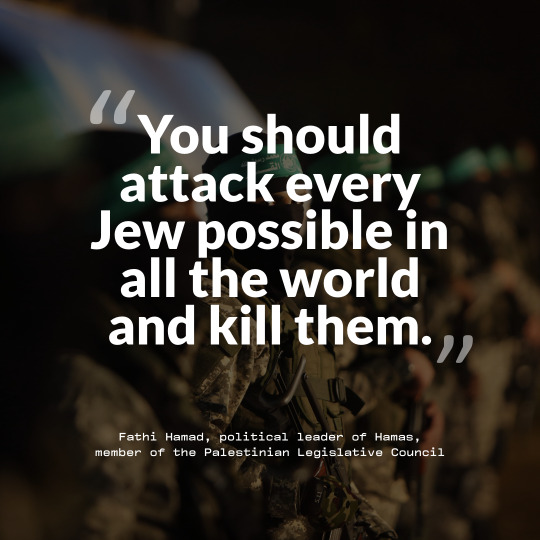
"Pro-Palestine" is pro-Hamas is pro-terrorism.
#hamas#islam#islamic terorrism#pro palestine#pro hamas#pro terrorism#intifada#globalize the intifada#exterminate hamas#this is islam#antisemitism#religion#religion is a mental illness
19 notes
·
View notes
Text
Images of 1912 fashion -
Left 1912 (April) Afternoon dress by Beer, Les Modes - photo by Talbot. From les-modes.tumblr.com/page/21 784X1920.
Center 1912 (June issue) Robe d'après-midi par Redfern from Les Modes. From Bibliothèque nationale de France via Wikimedia; fixed spots w Pshop 1453X2265.
Right 1912 (January) Tailored afternoon suit by Linker & Co., Les Modes - photo by Félix. From les-modes.tumblr.com/page/14 705X1920.

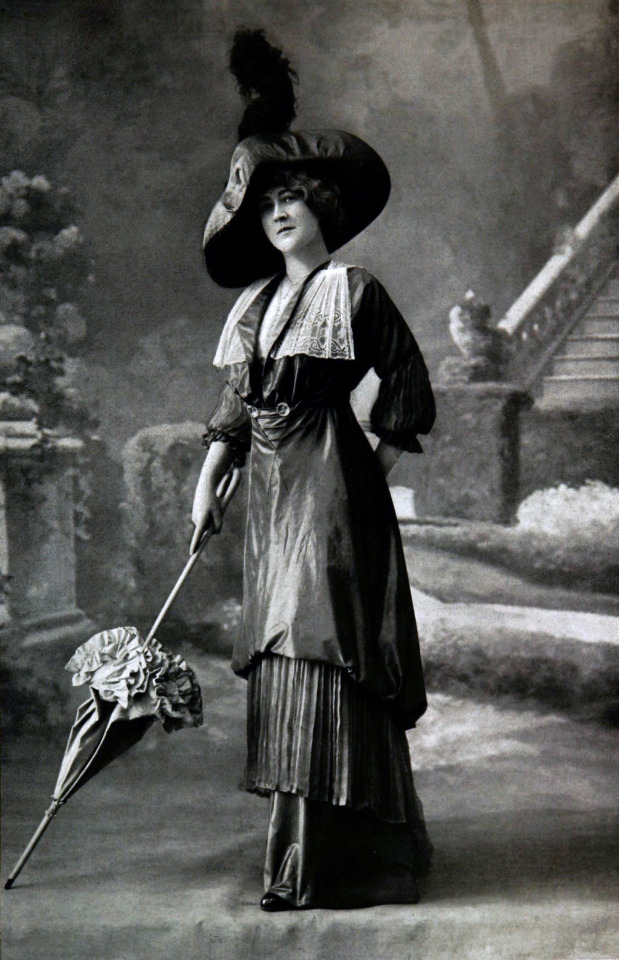
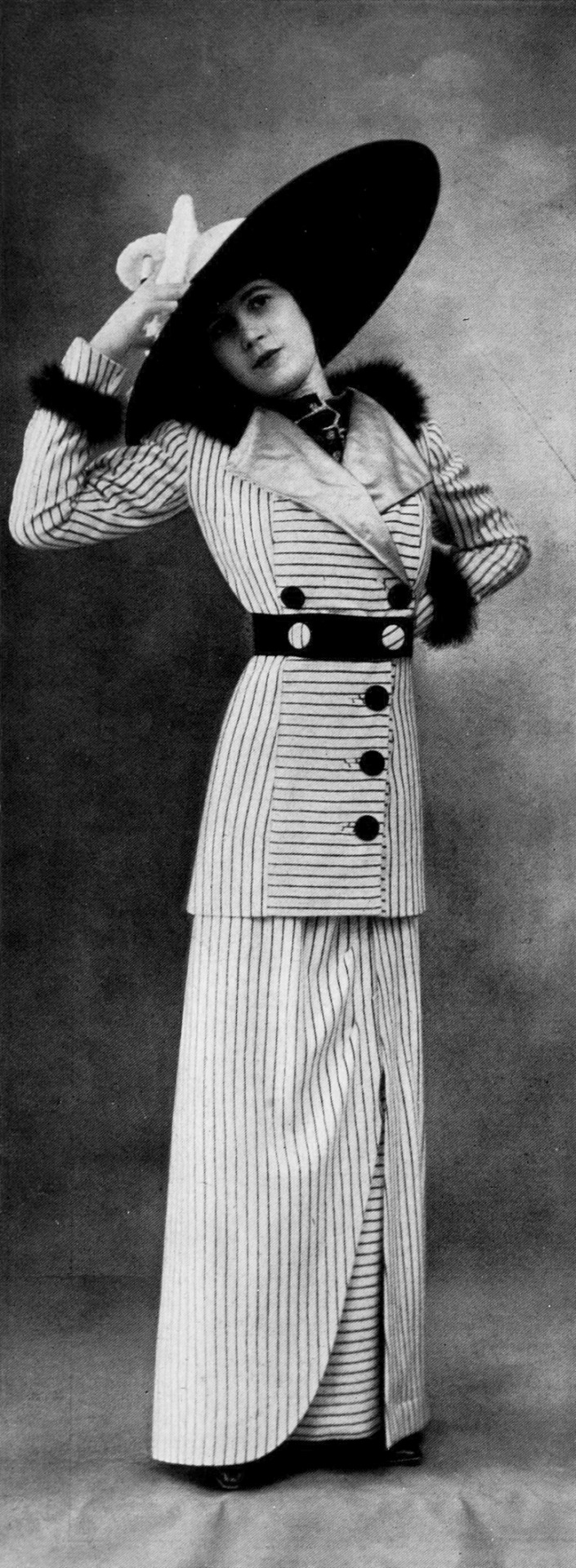
Left 1912 (August issue) Journal des Demoiselles print by A. Baeurlé (Rijksmuseum - Amsterdam, Netherlands). From their Web site 3277X4834.
Right 1912 Journal des Dames et des Modes. From tumblr.com/antiquebee/733887948520652800/journal-des-dames-et-des-modes-1912? 956X1705.

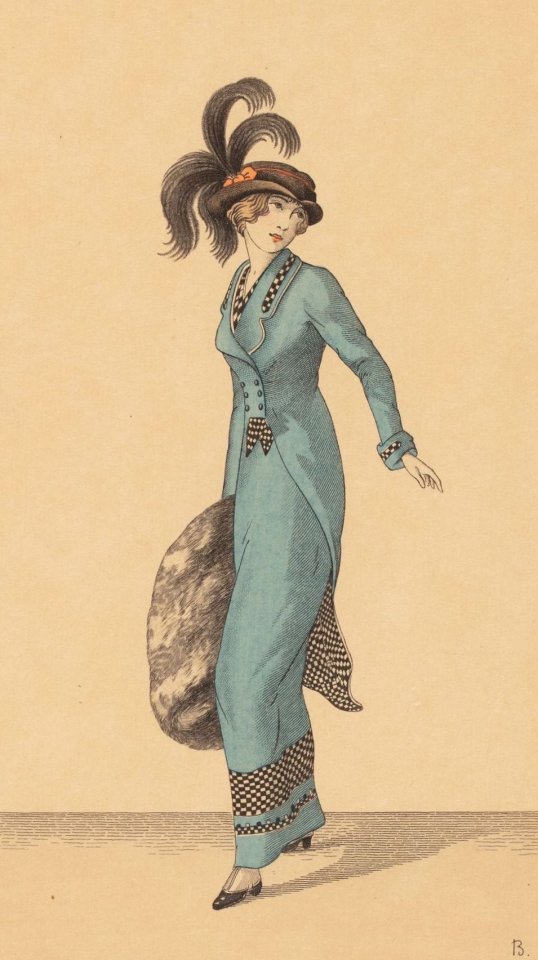
Left 1912 (September) Laferrière evening gown - photo by Félix, Les Modes. From les-modes.tumblr.com/page/10; fixed bigger spots w Pshop 1265X1920.
Right 1912 (September) Lelong evening gown, Les Modes - photo by Talbot. From les-modes.tumblr.com/page/10 1236X1920.

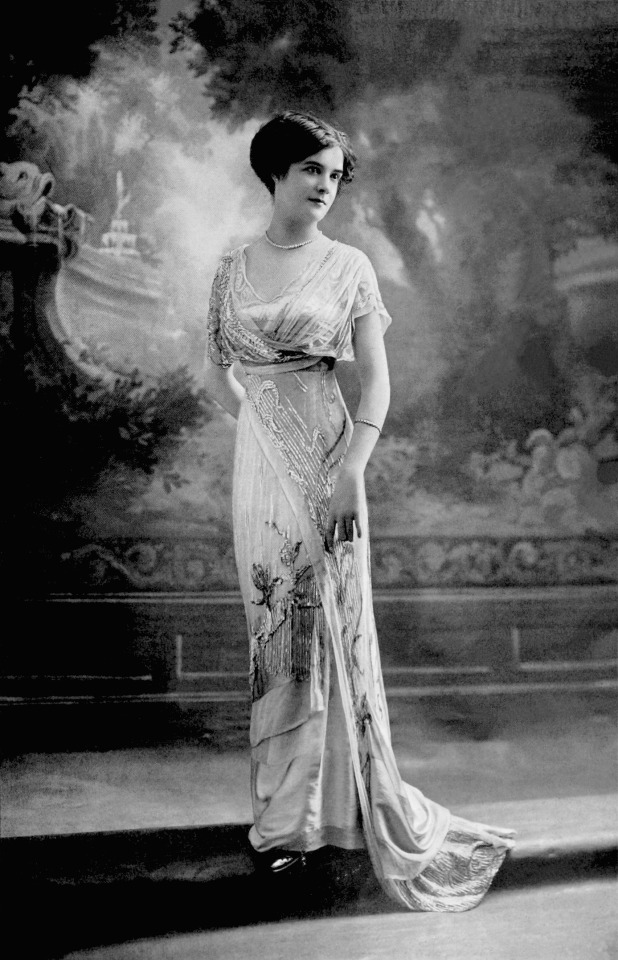
1912 (Winter) Jeanne Paquin evening gown (Helen Larson Historic Fashion Collection, FIDM Museum - Los Angeles, California, USA). From atkinreport.com/2015/07/21/television-academy-fetes-its-costume-design-emmy-nominees/ 1200X1600.

1912 (June) Vita Sackville-West at Ascot cropped 1396X1022
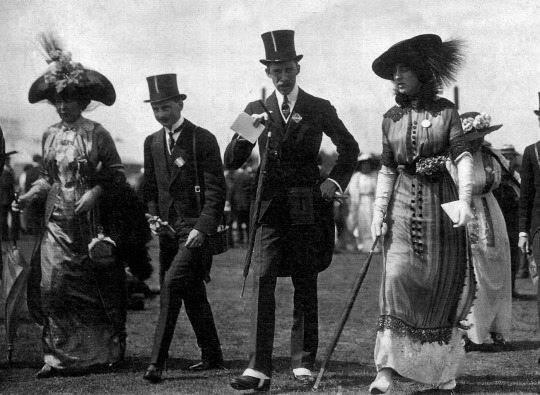
1912 (May) Dresses for the races by J. Dukes, photo by Reutlinger. From castaroundlesmodes.tumblr.com/post/68584847179/my-little-time-machine-dress-for-the-races-by?is_related_post=1 1280X1877.

Left 1912 Afternoon dress by Jeanne Hallée (Metropolitan Museum of Art - New York City, New York, USA). From their Web site 2568X2760.
Right 1912 (September issue) Robe d'après-midi par Redfern from Les Modes. From Bibliothèque nationale de France via Wikimedia; fixed bigger spots w Pshop & trimmed 1334X2118.
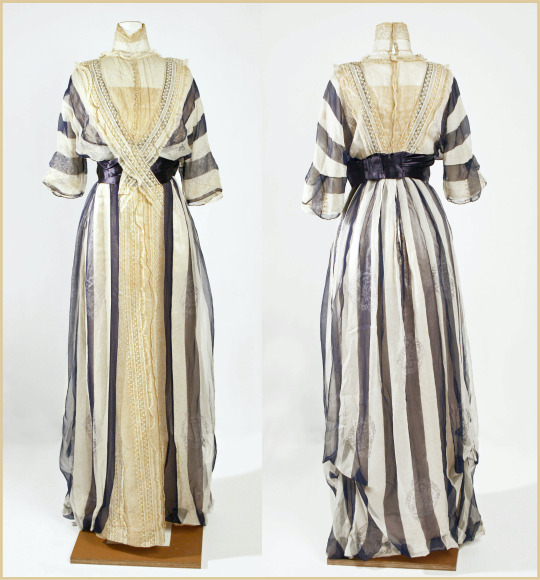
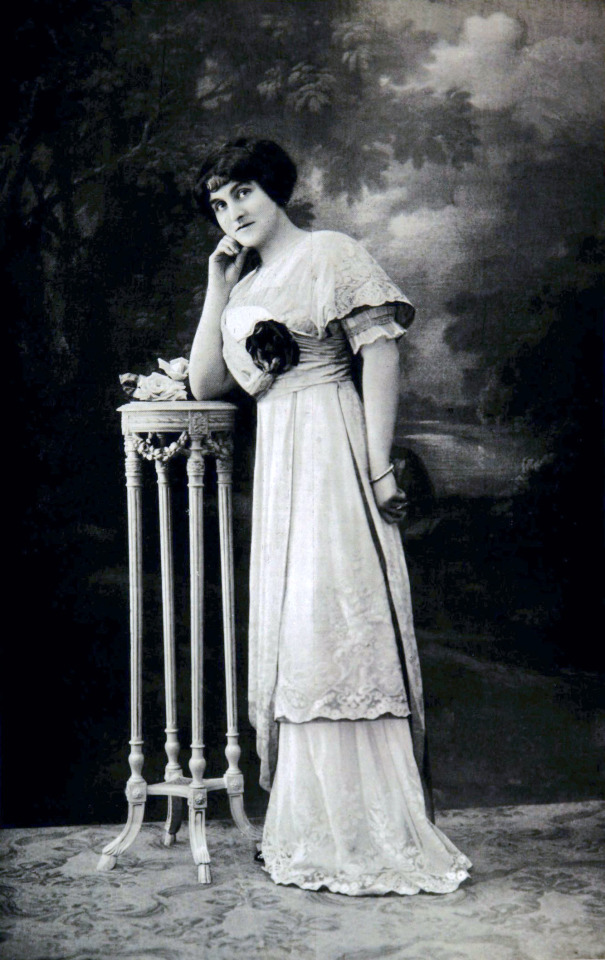
1912 Frieda Countess Logothetti née Baroness Zwiedinek of Südenhorst (1866-1945) by Karel Žádník (Slovácké Muzeum - Uherské Hradiště, Zlin Region Czech Republic). From Wikimedia 2784X3855.

Left 1912 Gustav Beer dress (National Gallery of Victoria - Melbourne, Victoria, Australia). From tumblr.com/lenkaastrelenkaa 1280X1855.
Right 1912 L'Adieu dans la nuit. Robe du soir de Paquin (pl.9, in La Gazette du Bon ton, 1912-1913 n°6) by André-Edouard Marty. From edition-originale.com/en/ 1680X2528.

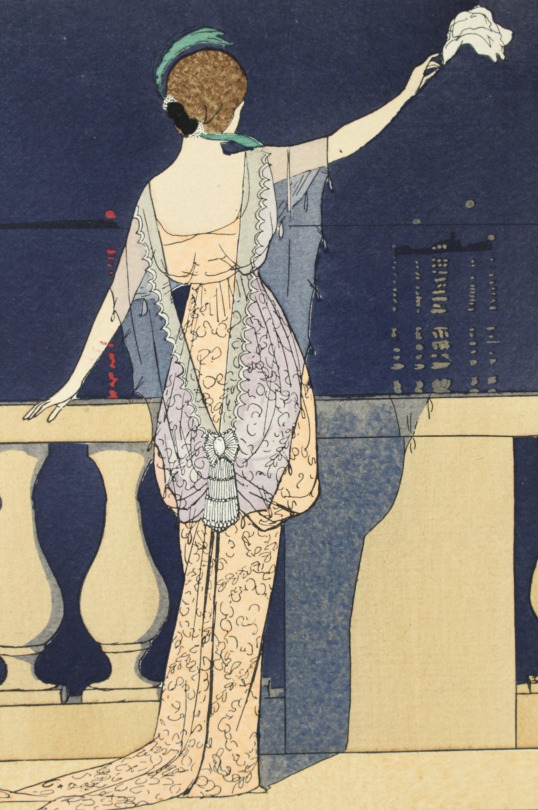
1912 Ladies attending the Henley Regatta in wide-brim hats, a feathered boa and curved-heel shoes. From vogue.co.uk/gallery/style-file-1912?image=5d54889ce144470008e44627 1280X1920.
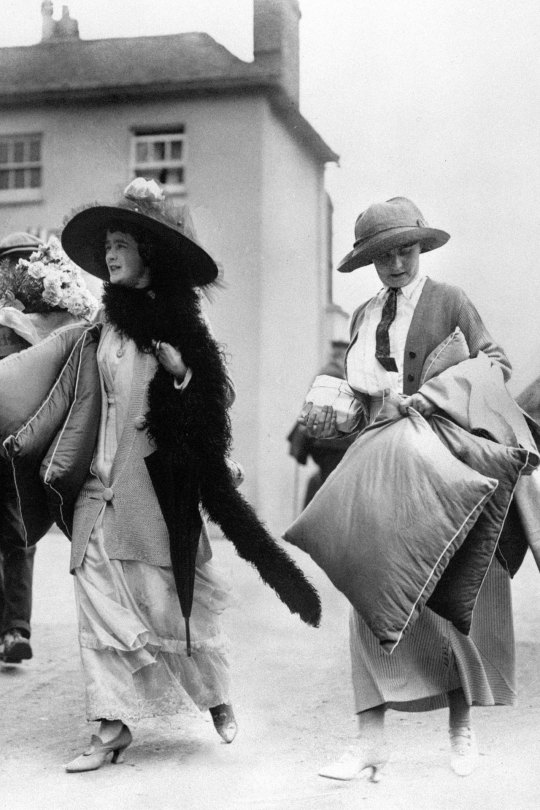
1912 Lady Cynthia Asquith by Bassano front and side 5112X3325.

1912 "Sorbet" by Paul Poiret (Victoria and Albert Museum). From omgthatdress.tumblr.com/page/2490.

#1912 fashion#1910s fashion#Belle Époque fashion#Edwardian fashion#Gustave Beer#Redfern & Sons#William Henry Fox Talbot#Linker & Co.#Félix#A. Baeurlé#Madeleine Laferrière#Lelong#Jeanne Paquin#Vita Sackville-West#J. Dukes#Reutlinger#Jeanne Hallée#Frieda Countess Logothetti#Karel Žádník#Cynthia Asquith#Bassano#Poiret#sorbet dress#flared over-skirt
24 notes
·
View notes
Text

St. Nicholas Day
St. Nicholas Day celebrates St. Nicholas, a popular minor Christian saint in Western and Eastern churches. In the fourth century, he was a bishop in Myra, a Greek town in the ancient district of Lycia, in Asia Minor, near present-day Demre, Turkey. The story of much of his life is not based on historical evidence, but on traditional stories and legends. It is believed that he was born in Patara, a seaport in Lycia, and that he traveled to Palestine and Egypt before coming to Myra. He was imprisoned for his beliefs by Roman Emperor Diocletian but was freed by Constantine the Great. He is believed to have been at the first council of Nicaea, and there are many legends that say he performed miracles for the poor. He was known for giving gifts and putting coins in people's shoes, and this influenced the way he is celebrated, as well as how other traditions during the Christmas season are celebrated.
St. Nicholas was buried in his church in Myra, and over the next few centuries, pilgrims began coming to his shrine. In 1087, his remains were stolen and taken to Bari, Italy. This increased his popularity in Europe, and Bari became a popular pilgrimage site. Most of his remains are still at the Basilica of San Nicola in Bari. His popularity continued to rise during the Middle Ages, but disappeared in most places except the Netherlands during the Reformation. His popularity has come back in Europe, and he has since become the patron saint of many places and people.
St. Nicholas Day is popular in Europe, particularly with children, because of the belief that St. Nicholas brings them gifts. Before the day, many European children place shoes or special St. Nicholas boots in front of fireplaces or outside of their front door at night. On the morning of the day, they receive small presents, such as candy, cookies, fruit, and small toys. Besides shoes or boots, presents are also placed in stockings, socks, or bags. In some countries, gifts are given on the eve of the day. In some European cities, especially those where he is the patron saint, the day is also marked with parades, feasts, and festivals. Some churches also have special services dedicated to the day.
Some in America also celebrate St. Nicholas Day. In the seventeenth century, the Dutch brought the tradition to New Amsterdam, which is now New York City. St. Nicholas had been called Sinterklaas in the Netherlands, and when he was brought to America he eventually became known as Santa Claus. During the nineteenth century, the Santa Claus we think of today came into his own. Similar to Sinterklaas in the Netherlands, Father Christmas of Britain is inspired by St. Nicholas. Another character, Krampus, is seen as being the evil companion of St. Nicholas.
How to Observe St. Nicholas Day
Children could celebrate by putting their shoes or boots in front of a fireplace or outside of their front door the night before the day. Stockings or socks could also be used. Parents could fill the shoes with small toys, candy, and other treats. Although the day is most celebrated by children and their parents, anyone can participate. You could even drop coins into people's shoes just as St. Nicholas did. Some cities have parades, feasts, and festivals which you could attend today. You could also plan a trip to the Basilica of San Nicola in Bari, where the remains of St. Nicholas are held.
Source
#St. Nicholas Day#St. Nikolaus#Samichlaus#Strasbourg#Alsace#France#fall 2010#day trip#Cathedral of Our Lady of Strasbourg#church#sculpture#original photography#tourist attraction#interior#6 December#SaintNicholasDay#StNicholasDay#6 December 343 AD#anniversary#history#Christmas time#travel#landmark
2 notes
·
View notes
Text
Amsterdam - Part 3
This is a continuation of Amsterdam - Part 2
Trigger Warning: Drugs
Amsterdam, Netherlands - October 2007
The Stedelijk Museum’s sleek white halls echoed faintly with the murmur of visitors as they shuffled from one exhibit to the next. Owl trailed behind his classmates, his eyes flicking over the displays of modern art without much interest, the supposed significance of each piece completely lost on him. Owl had planned to save his secret acquisition of the previous night for later, but the boredom gnawed at him. A dull ache in the back of his mind that grew more insistent with each passing minute. It was like a persistent itch he couldn’t scratch, the kind that made his skin crawl.
Owl made up his mind. He glanced around the room, making sure none of the teachers or his classmates were watching, before he quietly slipped away and followed the signs towards the restrooms. Once inside, Owl quickly made his way to one of the stalls at the far end, locking the door behind him. He reached into his pocket, pulling out the small plastic bag and stared at it for a moment. The fine white powder inside seemed so harmless in the harsh fluorescent light of the bathroom, but Owl knew better. He had read enough, seen enough, to understand what it was capable of—or at least what it was supposed to be capable of.
Owl carefully poured a small amount of the powder onto the flat surface of the toilet paper dispenser and used a card from his wallet to arranged it into a neat line. The steps seemed so familiar even though he had never done this before. He rolled up a bill, took a deep breath, leaned forward and inhaled the powder. The sensation was awful—a sharp, burning sting that shot up through his nose and into his sinuses, causing his eyes to water. Owl winced, waiting for the rush, the euphoria that was supposed to follow, the heightened alertness that would pull him out of the fog of boredom and into a state of exhilaration.
But nothing happened.
Instead of the expected rush and euphoria, Owl felt a strange calm settle over him. His thoughts, usually a whirlwind of scattered ideas and impulses, began to slow, each one falling neatly into place. The usual noise in his mind and the constant restlessness, were replaced by a stillness that he had never known before. It was as if the world had finally clicked into focus, but not in the way he had imagined. Owl frowned, his disappointment mingling with frustration and confusion. This wasn’t what he had expected at all.
Owl slumped against the wall of the stall as he tried to make sense of it all. The calmness was paradoxical, almost unsettling in its unfamiliarity. It took a while for Owl to realize what it might mean. He had suspected for a while now that he might suffer from ADHD but he had never been formally diagnosed. And now, here in the middle of a random restroom in Amsterdam, the evidence was staring him in the face. The very thing that was supposed to make him feel wired and energized, had instead done the opposite. A bitter laugh escaped Owl's lips as the realization sank in. In the end, the whole experience was just another reminder of how different he was. He stared down at the remnants of the powder still scattered on the dispenser like a cruel joke. He couldn't escape himself, no matter how hard he tried.
With a sigh, Owl wiped the dispenser clean and pocketed the baggie with the leftovers. He quickly composed himself, slipped out of the restroom and rejoined his classmates just in time before they left the museum. No one seemed to have noticed his absence, or at least no one seemed to care.
The class was now gathering at the entrance of the museum, preparing to leave for the next activity on the itinerary—a guided sightseeing tour of various historical sites around the city. The tour guide, a cheerful woman with a thick Dutch accent, began to lead them through the streets of Amsterdam, pointing out landmarks and sharing stories about the city's rich history.
At first, Owl found himself captivated by the tour. For the first time in as long as he could remember, he was able to focus on everything with a clarity that was alien to him. The guide’s words seemed to flow effortlessly into his mind, each fact and story slotting neatly into place. The world around him was quiet. The usual chaos in his mind was gone, replaced by a sense of calm that made everything feel manageable, almost easy. He marveled at how effortless it was to stay present, to absorb the information without the usual distractions pulling him away.
But soon enough, the effects began to wear off. The clarity and focus started to fade. The noise in his mind, started to creep back in, growing louder with each passing moment. What had been a soothing calm began slipping through his fingers like sand, leaving him grasping at the remnants as they dissolved back into the familiar chaos.
As the tour continued, the restlessness inside Owl intensified, escalating to a level that was almost unbearable, a gnawing presence that he couldn’t escape. Owl found himself unable to focus on the historical facts being shared or the beauty of the city around him anymore. His thoughts raced at an even more frantic pace than usual, each one more disjointed and fleeting than the last, never settling long enough for him to grasp. The more he tried to push the discomfort away, the more it clung to him, tightening its grip and threatening to swallow him whole. Owl’s thoughts spiraled and the tension kept building, like a coiled spring ready to snap at any moment. He wanted to scream, to lash out, to do something—anything—to make it stop.
He couldn’t afford to lose control. Not here. Not in front of his classmates, not out in public. The thought filled him with dread, the fear of the judgmental stares, the whispers behind his back, the looks of pity or disgust. He couldn’t let them see him unravel, couldn’t let them know just how close he was to the edge. He needed to get away before he snapped, before the carefully constructed mask he wore shattered in front of everyone.
Without a second thought, Owl slipped away from the group. No one noticed his departure, too engrossed in the tour guide’s lively explanations. Owl ducked into the nearest side street, the narrow alley providing a momentary refuge. He leaned against the cold brick, trying to steady his breathing, his hands trembling as he reached into his pocket and pulled out the small plastic baggie.
The remnants of the powder clung to the inside of the plastic, a faint dusting of white that was all that remained, but it would have to do. Owl’s hands shook as he carefully poured out what little was left on the back of his hand. There was no hesitation, no second thoughts. The need to silence the chaos in his mind, to bring back that fleeting calm, overpowered any sense of caution or rationality. He inhaled the powder in a single, desperate snort, the burn barely registering.
The effects were immediate, the gnawing anxiety and restlessness receding like a tide, replaced by the earlier clarity and focus again. The world around him snapped back into place. The noise in his mind quieted, the racing thoughts slowing down to a manageable pace. But he knew it wouldn’t last. It was only brief respite from the storm that would return with even greater force, once the effects wore off. But that wasn’t the point. Owl just needed it to last long enough for him to find something else, something stronger, something that would numb him completely. For now, at least, he could function.
Instead of returning to his classmates and the tour, Owl headed in a different direction. The encounter from the night before played in a loop in his mind, the memory beckoning him back to the red light district like a siren's song, the promise of escape and oblivion drawing him in, like a moth to a flame. Owl knew exactly what he neededed: Opiates. Codeine in the form of cough syrup had been his go-to for some time now; it was fairly easy to obtain. And right now Owl didn’t care what form the opiates took. He just needed them.
His feet moved with purpose, carrying him through the bustling streets and back to the place that was a unique and chaotic blend of temptation and despair, where desires were bought and sold in the open, unashamed and unabashed, the place where he had been offered something illicit with such casual ease. The district was just beginning to come alive, as dusk settled over the city. Owl weaved through the crowd, his senses on high alert, scanning the faces around him for any sign of familiarity. He needed to find the man from last night, or someone like him, someone who could provide what he was looking for.
Then, as if answering his unspoken plea, a figure emerged from the crowd. The stranger’s gaze locked onto Owl, as if he could see right through him, as if he recognized the familiar signs of someone on the edge. The man’s gaze lingered on Owl, sizing him up, before a knowing smirk tugged at the corners of his lips.
“Looking for something, kid?” the man asked in a low, gravelly voice. "I can tell when someone’s desperate," the man continued, taking a step closer to Owl. "And you, my friend, reek of it."
Owl’s heart skipped a beat. "I need something. Opiates, whatever you’ve got.", he replied not bothering with pleasantries.
The man’s smirk widened, recognizing the particular brand of desperation that Owl was exuding. "You don’t mess around, do you?" He reached into his pocket and pulled out a small plastic bag filled with pills. "Oxy. Will knock out whatever you’ve got going on up there," he said, tapping his temple. "But it’s gonna to cost you."
"I don’t care," Owl muttered, his hands shaking slightly as he fumbled with his wallet. "Just give it to me."
Knowing that he most likely could get away with it, the man named an outrageous price that would have made anyone flinch but Owl didn't care. He knew he was being ripped off but he handed over the money anyway. The man took it with a satisfied glint in his eyes, before pressing the the little bag of pills into Owl’s palm "There you go, kid. Don’t take them all at once," he added with a chuckle, as if the warning was more of a joke than anything else.
Owl didn’t bother responding. He slipped the pills into his pocket, turned on his heel, and walked away from the man, heading towards a quieter part of the district where he could be alone. He found a secluded spot and fished out one of the pills from the bag. Owl held it between his fingers for a moment, his gaze fixed on the small tablet. Then he simply popped it into his mouth and swallowed it dry, the bitter taste lingering on his tongue.
Owl knew it would take some time for the pill to kick in, and he didn’t want to take any chances with it being another letdown. So, he set out again to find a bottle of liquor. The red light district had no shortage of places to buy alcohol. It didn’t take long for him to find what he was looking for. Owl pushed the door open and stepped inside, the faint chime of a bell announcing his arrival. The interior was cramped, the shelves lined with bottles of every shape and size. Owl’s eyes scanned the shelves, searching for something that would do the job, something that would hit hard and fast.
And then he saw it—the familiar label of a single malt scotch whisky that his father often kept in his study. The sight of the bottle brought back a flood of memories, none of them particularly pleasant. It was the kind of whisky that was meant to be savored, the kind of whisky that connoisseurs would appreciate for its rich, complex flavors. But Owl didn’t care about any of that. He wasn’t even particularly fond of the taste either but the familiarity was comforting in a twisted sort of way. And, more importantly, it was strong. It was perfect for what he needed right now
The bottle was expensive—far more than anyone should ever be spending on alcohol—but Owl didn’t care. He grabbed it off the shelf and brought it to the counter. The cashier eyed him with mild curiosity, but said nothing as Owl paid for the whisky and left the shop
As he stepped back out into the night, still waiting for the effects of the oxy to kick in, Owl considered his options. He could return to the hostel, but the thought of facing his classmates in his current state made his stomach churn. He couldn’t let them see the trainwreck that he was. No, that definitely wasn’t an option. Owl made up his mind quickly, turning away from the direction of the hostel and setting off in the opposite direction towards Vondelpark. He had passed the park earlier in the day during the tour, a sprawling green space in the heart of the city. It had seemed peaceful, a place where people could lose themselves in nature, away from the noise and chaos of the streets. That was exactly what he needed now.
As Owl walked, he uncorked the whisky bottle and took a long, burning swig. The liquid seared his throat, the familiar harshness making him wince. The scotch was strong, and it hit him almost immediately, the warmth spreading through his chest and stomach. He took another swig, his steps becoming slightly more unsteady as the alcohol began to take effect. By the time he reached Vondelpark, the world had taken on a dreamlike quality, everything softer and more distant. The effects of the oxy were finally beginning to mix with the alcohol.
Owl wandered into the park, the trees towering above him, their leaves rustling softly in the breeze. The paths were mostly empty at this hour, the occasional jogger or cyclist passing by, but no one paid him any attention. He felt invisible, like a ghost drifting through the night.
He found a secluded spot near a small pond, the water reflecting the pale light of the moon. The gentle ripples on the surface seemed to dance with the wind, creating an almost hypnotic pattern. Owl slumped down onto the grass, the bottle of whisky dangling loosely from his fingers. The world around him was slowly fading into a blur. The warmth in his chest spreading to create a sensation that was intoxicating in its perfection. But even in this state, a small part of him still craved more. The darkness that always lurked at the edges of his mind whispered that this wasn’t enough, that he could push it even further.
Without fully registering what he was doing, Owl fished out another pill from the bag, his fingers unsteady as he popped it into his mouth and swallowed it down with another swig of whisky. The bitter taste of the pill mixed with the sharp burn of the alcohol, but Owl didn’t care. He just wanted to sink deeper into the oblivion that was slowly wrapping around him like a comforting blanket.
And then it finally hit him.
The combination of the oxy and the alcohol slammed into Owl like a tidal wave, a rush of warmth and euphoria that swept through his entire being. He closed his eyes, letting the sensation take him, feeling as though he were floating above the earth, weightless and free. The world, with all its pain and pressure, all its demands and expectations, seemed to melt away, leaving behind only a perfect, blissful numbness. Owl had finally found the escape he had been searching for, a place where nothing could touch him, where he could simply exist without the burden of his own existence. In this state, Owl didn’t have to think, didn’t have to feel. There was no past, no future, just the present moment, suspended in time.
It was bliss. Pure, unadulterated bliss.
And then, there was nothing.
Continue reading here
3 notes
·
View notes
Text
July 30, 2023
BARCELONA, Spain (AP) — Spanish government researchers said Sunday they had identified 357 foreign fighters who went missing during the Spanish Civil War (1936-1939), the conflict that foreshadowed World War II.
Researchers confirmed the names of 212 fighters from Germany, Austria and the Netherlands, according to a statement from the government Sunday. Some 102 are of German origin, 70 Austrian and 40 Dutch. It gave no information on how many people of other nationalities had been identified.
The identified combatants fought within the International Brigades, military units set up by the Communist International to fight against General Francisco Franco’s fascist forces. Some 40,000 foreign men and women joined up as volunteers, fighting alongside the forces of the democratic Second Spanish Republic and against the rise of fascism in Europe in late 1930s.
The findings are based on a year of research in records held in documentary archives in Spain and Russia. Researchers combed through the daily lists of casualties and missing soldiers compiled by officers in the International Brigades.
The names of private soldiers were frequently omitted from the lists, making the research process more difficult. These lists are held in the Russian State Archive of Socio-Political History, in Moscow. Researchers also dipped into the main archives on the Spanish Civil War located in Spain.
By cross-referencing documents, researchers were also able to identify the likely area where the soldiers died or were badly wounded. It is an important step toward locating their remains inside mass graves scattered across the country.
This research provides “very valuable information that gives us the opportunity to contact the families of the missing combatants and, in the future, to intervene in the mass graves that have been located,” said Alfons Aragoneses, head of the project.
All those identified were part of the Thälmann Brigade, a Communist unit made up largely of anti-Nazi Germans. The battalion was active on the Ebro River front in northeastern Spain between March and September 1938, the site of the longest and deadliest battle of the war.
The research is ongoing and it is funded by Catalan regional government, with the aim of contributing to the country’s historical memory. The second phase of the project will try to identify missing militiamen from Great Britain, Ireland, Canada and the United States. The final step would require opening the graves in search of bodies.
Historians estimate nearly 10,000 foreign volunteers died in combat on Spanish soil during the war. How many are still unidentified, buried inside graves, remains unknown.
The Spanish Civil War served as a testing ground for Hitler’s Germany and Mussolini’s Italy prior to World War II. This triggered an international outcry to try to save the Republic’s democratic government, which eventually succumbed to Franco in 1939.
17 notes
·
View notes
Note
My esteemed friend,
May I trouble you for some insider knowledge on Count Tilly (the year being 1622) wrecking Heidelberg?
Many thanks in advance
Oh my, that's a rather specific question, my dear friend!
I have to say, Tilly isn't my speciality; what I do know is though that a set of archeological findings from the time of Tilly laying siege to Heidelberg was coloquially named after him, and that Heidelberg has a historic trail route you can hike along to experience the sites of the siege.
Other than that, I just know the obvious basics and context of the wider conflict (the 30 Years' War, with Frederick V., Count Palatine of the Rhine, whose 'capital' Heidelberg was, involved as he had briefly been the King of Bohemia but had been ousted as the result of the Battle of the White Mountain in 1620). For any 'special' titbits, i. e. things you couldn't learn from the Wikipedia article, I think I am the wrong person to ask.
I am trying to think about Tilly-specific-Heidelberg-related things, but all I can come up with are later off-hand comments and reflections on the 30 Years' War by Frederick V.'s children and grandchildren, as I am quite familiar with the Palatine family, just at a slightly later date when the ex-King and Queen of Bohemia, unable to return to the Palatinate, and their ever-growing brood of children were living in the Netherlands.
I think, not being knowledgeable enough when it comes to the specific Stadtgeschichte of Heidelberg, I am the wrong person to answer your question, alas!
I can however offer you, as recompense, something amusing from the later letters of the Ex-Queen of Bohemia, or observations on life in her household in the late 1650s? She was instrumental in trying to broker a deal allowing her eldest surviving son to return to the Palatinate, but, the two having very much differing political views, they grew apart (there were other things standing between mother and son, too- animal hoarding, parentification and being mediocre at finances, to name but three explosive topics). She never returned to the Palatinate, whereas her son did, and subsequently transformed the castle at Heidelberg into the stuff of soap operas -- but that was decades after the siege in 1622.
Sorry that I can't be of greater help, my friend! If anyone has a Heidelberg-related Tilly titbit, please share it! :D
5 notes
·
View notes
Text
Aachen - Germany
The home to the throne of Charlemagne.
youtube
A tour of the city of Aachen: the throne of the Holy Roman Empire is here, in the Cathedral. The Byzantine style cathedral was later decorated with the rich patterns we see now. In the days of Charlemagne those weren't there.
Aachen is a fascinating city with a rich history, and there are many interesting facts that most people don't know about.
First of all, Aachen is located in western Germany, near the border with Belgium and the Netherlands. It was once the capital of the Frankish Empire, and later the Holy Roman Empire. The city is known for its historic architecture, including the impressive Aachen Cathedral, which was built in the ninth century and served as the coronation church for German kings and queens for centuries.
One of the most interesting facts about Aachen is that it was the favorite city of Charlemagne, the famous Frankish king who ruled from 768 to 814. Charlemagne spent a great deal of time in Aachen, and it was here that he built his palace, which became the center of his empire. The palace was known as the Palatium Aquisgranum, and it was one of the most impressive buildings of its time. Unfortunately, very little of it remains today, but you can still see some of the original walls and foundations if you visit the city.
Aachen was also the site of one of the most important treaties in European history. In 843, the Treaty of Verdun was signed in Aachen, which divided the Frankish Empire into three parts and laid the foundation for the modern states of France, Germany, and Italy. The treaty was negotiated by Charlemagne's grandsons, who had been fighting for control of the empire for several years. The Treaty of Verdun is considered one of the most significant events in European history, and it marked the end of the Carolingian dynasty.
#aachen#germany#deutschland#allemagne#charlemagne#history#cathedral#citytrip#city#architecture#tourism#travel#youtube#youtubetravel#wanderlust#wonderjourneys#aken#carlomagno#byzantine#roman#rome#mittelalter#middleages#medieval#altstadt#Youtube
19 notes
·
View notes
Text


The Van Nelle factory in Rotterdam, since 2014 a UNESCO World Heritage Site, is the chief work of the architectural firm Brinkman & Van der Vlugt and an icon of interwar modernism in Europe. Revolving around Johannes Brinkman and Leendert van der Vlugt the office was one of the most prolific in the Netherlands and attracted young talents like Jan Gerko Wiebenga, who also worked on the Van Nelle Factory, or Mart Stam. Owing to a progressive metropolitan clientele as well as an aspiring municipality the office was able to realize a great number of modernist buildings, among them single-family homes like the Sonneveld House, the Bergpolderflat apartment building or the Feijenoord Stadium.
A number of Brinkman & Van der Vlugt’s buildings have been restored by architect Joris Molenaar who fittingly also is the author of the present monograph „Brinkman en Van der Vlugt architecten - Rotterdams City-Ideaal in International Style“, published in 2012 by NAi010 Publishers. Against the background of Molenaar’s practical experience with the office’s buildings it doesn’t surprise that the latter also form the backbone of the book: along seven chapters and a selection of 20 buildings the author elaborates the architects’ design/building process and in turn seeks to connect it with contemporary ideas of the ideal city in general and Rotterdam in particular. This aspect probably is the weakest part of the book since it never becomes quite clear what their specific contribution to modern Rotterdam was beyond their undoubtedly modern buildings.
What is more convincing is the juxtaposition of the wealth of archival material, including plans and photos, Molenaar has brought together in the book and Iwan Baan’s contemporary photographs: they enable the reader to evaluate the historic buildings in their present-day context in which they have become a permanent part in a continuously changing fabric.
„Brinkman en Van der Vlugt architecten - Rotterdams City-Ideaal in International Style“ is a comprehensive monograph that provides a visually stunning overview of one of Dutch modernism’s most remarkable offices.
#brinkman en van der vlugt#monograph#modernist#architecture#netherlands#dutch architecture#architecture book#nai010 publishers#architectural history
18 notes
·
View notes
Note
What do you think the inner circles (ACOTAR) preferences are for a perfect vacation ?
Eg.
Feyre- big city to see art and architecture! (Paris in the spring?)
Hi nonnie!
Such a good question. Okay, let me think about this...
Feyre: Feyre has a bucket list of art museums all over the world that she wants to see, so she picks one to visit and makes a vacation out of it. The Louvre Museum in Paris, The Vatican in Italy, etc.
Rhys: Rhys, much like his mate, has a bucket list of museums for his obsession with space and the universe. He'd go to the Smithsonian National Air and Space Museum, but he really wants to take Feyre to see the Northern Lights.
Elain: Elain is 100% going to the Tulip Fields near Amsterdam. Her dream is to frolic in the flowers and then tour different parts of Amsterdam and the Netherlands.
Azriel: Azriel just wants to take Elain on every adventure her heart desires. He doesn't care where they end up. But his perfect spot is an isolated cabin in the woods, away from the hustle and bustle of the city where he can just relax in peace. With Elain, of course. 😉
Nesta: Nesta is like a scholar and always wants to explore different ruins and historically rich sites. The great pyramids in Egypt are at the top of her list. She may also tag along with Cassian to check out some of the ancient ruins of Europe.
Cassian: Cassian is obsessed with warriors and gladiators of ancient times, so he spends his vacation time touring the Colosseum Arena in Italy and other similar architectural pieces of Italy and Greece.
Mor: Mor is spending every vacation at fashion week in Millan. Or she's shopping in New York. Wherever she goes, she's always coming home with a new wardrobe.
Amren: Amren is jewel shopping. That's it. That's the vacation. Buying large, ostentatious pieces from around the world.
10 notes
·
View notes